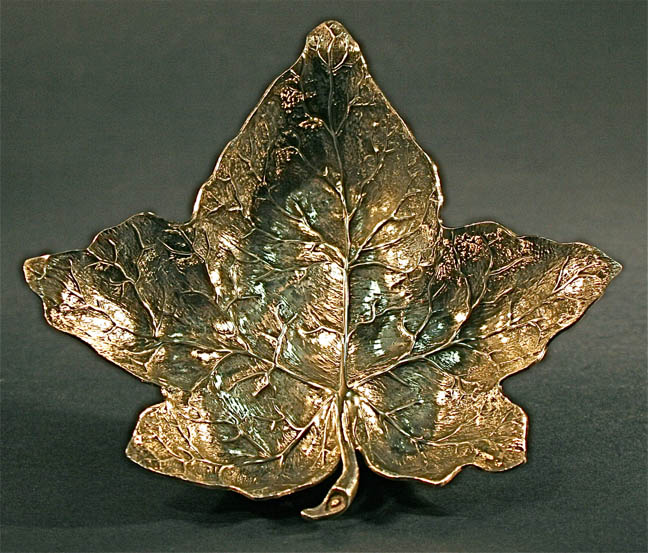

Title: Buccellati handcrafted ivy leaf sterling silver little dish
Shipping: $18.00
Artist: N/A
Period: Contemporary
History: N/A
Origin: Southern Europe > Italy
Condition: Museum Quality
Item Date: 1980 to 2000
Item ID: 3014
This delicate sterling silver Ivy Leaf is handcrafted in Italy by the skilled artisans of Buccellati. The spreading Evergreen, the Ivy Leaf, is represented by Buccellati in Sterling Silver. Nature inspired, Italian sterling silver gift or table accessory from Buccellati. This delicate sterling silver Ivy Leaf is handcrafted in Italy by the skilled artisans of Buccellati. Small measures 3.5" Medium measures 5.5" The collection is delightfully original. Made precious by their design and artisan-intensive workmanship, the giftware possesses an inimitable style? that same style, which is present in any object, signed Buccellati. We invite you to explore our extensive collection of fine quality art merchandise from Europe and around the world. Gifts of all kinds. The brands we feature are among the very best in the world. We are committed to the highest standards of quality and personal service. As much of our business is custom or special order, if you don't see it just ask. We are the worlds possibility art gallery....
Buccellati and their sterling silver creations! Let's take a stroll through history, shall we? The Buccellati brand has a rich history dating back to the early 20th century. It was founded by Mario Buccellati in 1919 in Milan, Italy. Mario had a passion for jewelry and silversmithing, and he began his career as a goldsmith, creating unique and intricate pieces. Buccellati gained recognition for its exceptional craftsmanship and distinctive style. One of the notable features of Buccellati's silverwork is the intricate hand engraving, which became a signature element of the brand. The artisans at Buccellati were (and still are) known for their meticulous attention to detail and dedication to traditional craftsmanship. Over the years, the Buccellati brand expanded its reach, opening boutiques in various fashion capitals around the world. The family-run business continued to pass down its skills and techniques from one generation to the next, maintaining a commitment to artisanal craftsmanship. Buccellati's sterling silver pieces are often characterized by elaborate designs, inspired by nature and Renaissance art. The silverware includes everything from flatware and tea sets to decorative objects and jewelry. Each piece is a work of art in itself, reflecting the brand's dedication to timeless elegance. In 2019, Buccellati celebrated its centennial, marking a century of creating exquisite handcrafted silver pieces. The brand's legacy continues to thrive, and its creations are sought after by collectors and connoisseurs of fine craftsmanship worldwide.
Link: http://en.wikipedia.org/wiki/Silversmith
A silversmith is a person who works primarily making objects in solid silver; historically the training and guild organization of goldsmiths included silversmiths as well, and the two crafts remain largely overlapping. Unlike blacksmiths, silversmiths do not shape the metal while it is red-hot but instead, work it at room temperature with gentle and carefully placed hammerblows. The essence of silversmithing is to take a flat piece of metal and by means of different hammers, stakes and other simple tools, to transform it into a useful object. While silversmiths specialize in, and principally work, silver, they also work with other metals such as gold, copper, steel, and brass. They make jewellery, silverware, armour, vases, and other artistic items. Because silver is such a malleable metal, silversmiths have a large range of choices with how they prefer to work the metal. Historically, silversmiths are mostly referred to as goldsmiths, which was usually the same guild. In the western Canadian silversmith tradition, guilds do not exist; however, mentoring through colleagues becomes a method of professional learning within a community of craftspeople. Silver is cheaper than gold, though still valuable, and so is very popular with jewellers who are just starting out and cannot afford to make pieces in gold, or as a practicing material for goldsmith apprentices. Silver has also become very fashionable, and is used frequently in more artistic jewellery pieces. There are several different types of silversmiths: Some are involved in the fabrication of the metals, where items are typically cut and then constructed with differing connections, such as soldering or riveting. Others work in wax and then cast their pieces using a process called lost wax casting, where the wax original is evaporated in a burn-out process in a kiln. There are silversmiths who specialize in forging and forming, which produces pieces that are typically made from a single piece of metal that has been hammered or formed under the pressure of percussion or squeezing from a press, such as a hydraulic press. In the Canadian western tradition, silversmithing is done through hand tooling and bright cut engraving of silver. There are silversmiths who only make jewellery and there are silversmiths who only make utensils. Traditionally silversmiths mostly made "silverware" (cutlery, table flatware, bowls, candlesticks and such). Only in more recent times has silversmithing become mainly work in jewellery, as much less solid silver tableware is now handmade.